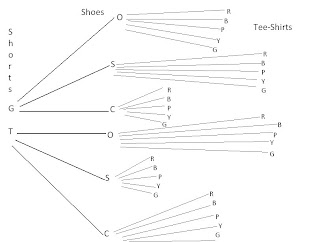Hi guys.
So I'm sorry I didn't write yesterday... Although I'm pretty sure I don't any avid readers who would be too upset about that... Anyways.
In Math we had our Algebra Unit Quiz and now we are starting on third term Algebra: word problems. This is just like translations, except we have to solve the equation. There are four steps to solving a word problem.
1. Write your "let" statement
2. Write the equation
3. Solve the equation
4. Write a statement answering the question
So, here are some examples of one-step word problems and answers.
Q: Mary will be 31 years old in 14 years. How old is Mary now?
A: Let c represent how old Mary is now
c + 14 = 31
c + 14 - 14 = 31 - 14
c = 17
Mary is seventeen years old.
Q: 7 times a certain number is 56. What is the number?
A: let x represent the number
7x = 56
7x / 7 = 56 / 7
x = 8
The number is eight.
Now, here is an example of a 2-step word problem.
Q: David spent $12.50 at the candy store. He spent $5 on a bag of Gummy Bears. He spent the rest on 6 chocolate bars. What was the cost of one chocolate bar?
A: Let q represent the cost of one chocolate bar
$5 + 6q = $12.50
$5 - $5 + 6q = $12.50 - $5
6q = $7.50
6q / 6 = $7.50 / 6
q = $1.25
One chocolate bar costs $1.25.
In Science we started a new unit on water systems. We learned about the water cycle a few days ago. In the water cycle, the water starts out in the ocean basin, as the water always wants to take the lowest possible position. When the sun shines down on the water, it evaporates and turns into water vapor. As it rises up, the vapor cools and condenses into droplets. These droplets create a cloud suspended in the air. As more and more droplets join the cloud, it basically becomes a saturated mixture with the air. When it reaches that saturation point and no more droplets can be added, the water goes to the bottom of the cloud. (Think of when you add Kool-Aid mix to water. When you hit the saturation point, all of the extra mix is at the bottom of the glass.) These droplets then fall as precipitation. The fallen water either goes directly back into the ocean if the cloud hasn't moved, or it goes onto the Earth. The water then becomes surface run-off and runs into a river or stream that eventually leads back to the ocean.
Something I was thinking about was why rain isn't salty if it comes from saltwater oceans. The answer to this is something we learned in grade 7 when we learned both about pure substances and mixtures, and heat. When the salty ocean water is heated and turns into vapor, only the water has hit its boiling point. The salt hasn't, and therefore doesn't change states. So the vapor in the air is freshwater. That is why we can use it for tasks such as watering plants.
I have to go now, so...
Until next Wednesday
-K


